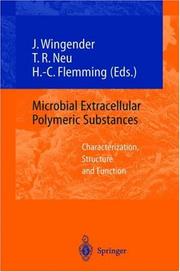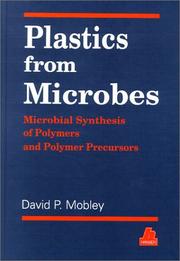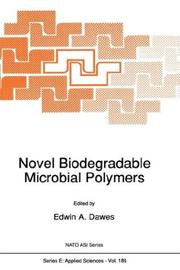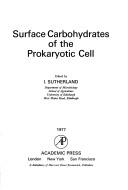| Listing 1 - 10 of 11 | << page >> |
Sort by
|

ISBN: 3540657207 9783540657200 Year: 1999 Publisher: Berlin: Springer,
Abstract | Keywords | Export | Availability | Bookmark
 Loading...
Loading...Choose an application
- Reference Manager
- EndNote
- RefWorks (Direct export to RefWorks)
Book
ISBN: 1282563246 9786612563249 1615834516 1847351190 9781847351197 1847351174 9781847351173 1847351182 9781847351180 9781615834518 9781847351173 9781847351180 Year: 2010 Publisher: Shawbury, Shrewsbury, Shropshire, UK ISmithers
Abstract | Keywords | Export | Availability | Bookmark
 Loading...
Loading...Choose an application
- Reference Manager
- EndNote
- RefWorks (Direct export to RefWorks)
Polyhydroxyalkanoates (PHA) are plastic-like polymers produced naturally by many types of bacteria. PHA are among the most promising next generation plastics because they are biodegradable and can be produced using renewable resources. This Practical Guide to Microbial Polyhroxyalkanoates provides detailed information on the various microbial aspects that govern the design and synthesis of commercially useful PHA. Unlike chemical polymerisation processes, the microbial system involves multiple biological catalysts that convert renewable carbon sources into monomers and finally high molecular w
Microbial polymers. --- Plastics --- Microbiology.
Book
ISBN: 1909030643 9781909030640 1909030619 Year: 2015 Publisher: Shrewsbury : Smithers Rapra,
Abstract | Keywords | Export | Availability | Bookmark
 Loading...
Loading...Choose an application
- Reference Manager
- EndNote
- RefWorks (Direct export to RefWorks)
Microbial polymers. --- Poly-beta-hydroxyalkanoates. --- PHA (Polymer) --- Poly-3-hydroxyalkanoates --- Microbial polymers --- Polyesters --- Biopolymers --- Microbial metabolites
Book
ISBN: 3030422151 Year: 2022 Publisher: Cham, Switzerland : Springer,
Abstract | Keywords | Export | Availability | Bookmark
 Loading...
Loading...Choose an application
- Reference Manager
- EndNote
- RefWorks (Direct export to RefWorks)
Microbial polysaccharides. --- Medical microbiology. --- Microbial polymers --- Polysaccharides --- Polisacàrids
Book
ISBN: 9781780407418 Year: 2017 Publisher: London : IWA publishing,
Abstract | Keywords | Export | Availability | Bookmark
 Loading...
Loading...Choose an application
- Reference Manager
- EndNote
- RefWorks (Direct export to RefWorks)

ISBN: 3446173676 1569901287 Year: 1994 Publisher: Munich ; New York : Cincinnati : Hanser Publishers ; Distributed in the USA and in Canada by Hanser/Gardner Publications,
Abstract | Keywords | Export | Availability | Bookmark
 Loading...
Loading...Choose an application
- Reference Manager
- EndNote
- RefWorks (Direct export to RefWorks)
Microbial polymers. --- Plastics --- Biotransformation (Metabolism) --- Biotransformation (Métabolisme) --- Microbiology.

ISBN: 0792309499 9401074585 9400921292 9780792309499 Year: 1990 Volume: 186 Publisher: Dordrecht : Kluwer academic,
Abstract | Keywords | Export | Availability | Bookmark
 Loading...
Loading...Choose an application
- Reference Manager
- EndNote
- RefWorks (Direct export to RefWorks)
Book
ISBN: 3038426369 Year: 2017 Publisher: Basel, Switzerland : MDPI,
Abstract | Keywords | Export | Availability | Bookmark
 Loading...
Loading...Choose an application
- Reference Manager
- EndNote
- RefWorks (Direct export to RefWorks)
Currently, we are witnessing highly dynamic research efforts related to the exciting field of novel biodegradable plastic-like materials. These activities originate from a growing public awareness of prevailing ecological problems associated to, e.g., rising piles of plastic waste, increasing greenhouse gas emissions, and ongoing depletion of such fossil resources usually used for the synthesis of "full carbon backbone" plastics. Polyhydroxyalkanoate (PHA) biopolyesters, a family of versatile plastic-like materials produced by living microbes, are a future-oriented alternative to traditional plastics. If accomplished in an optimized way, production and the entire lifecycle of PHA are embedded into nature´s closed carbon cycle, which is underlined by PHA´s main benefits of being "biobased", "biosynthesized", "biocompatible", and "biodegradable". Sustainable and economically feasible PHA synthesis, especially on an industrially relevant scale, requires all production steps to be understood and improved. Among other aspects, this calls for new powerful production strains to be screened; knowledge about the proteome and genome of PHA accumulating organisms to be consolidated; the kinetics of the bioprocesses to be thoroughly understood; abundantly available inexpensive raw materials to be tested; the monomer composition of PHA to be adapted; (bio)chemical engineering to be optimized; and novel PHA recovery strategies to be developed in order to reduce energy and chemical inventory. The present book provides a comprehensive compilation of articles addressing all these different aspects; the individual chapters were composed by globally recognized front running experts from special niches of PHA research. We are convinced that this book will be of major benefit to the growing scientific community active in biopolymer research.
Biodegradable plastics. --- Poly-beta-hydroxyalkanoates. --- PHA (Polymer) --- Poly-3-hydroxyalkanoates --- Microbial polymers --- Polyesters --- Degradable plastics --- Environmentally degradable plastics --- Environmentally friendly plastics --- Green plastics --- Biodegradable products --- Biopolymers --- Plastics --- Biodegradation

ISBN: 0126778507 9780126778502 Year: 1977 Publisher: London Academic press
Abstract | Keywords | Export | Availability | Bookmark
 Loading...
Loading...Choose an application
- Reference Manager
- EndNote
- RefWorks (Direct export to RefWorks)
Microbial polysaccharides --- Bacterial cell walls --- Prokaryotes --- 577.124 --- 579.234 --- Monera --- Procaryotae --- Procaryotes --- Prokaryonta --- Prokaryotae --- Prokaryotic protists --- Microorganisms --- Microbial polymers --- Polysaccharides --- Bacterial membranes --- Cell walls, Bacterial --- Bacteria --- Cell membranes --- Carbohydrate metabolism --- Cell wall. --- Bacterial cell walls. --- Microbial polysaccharides. --- Prokaryotes. --- 579.234 Cell wall. --- 577.124 Carbohydrate metabolism --- Cell wall
Book
ISBN: 9811600457 9811600449 Year: 2021 Publisher: Singapore : Springer,
Abstract | Keywords | Export | Availability | Bookmark
 Loading...
Loading...Choose an application
- Reference Manager
- EndNote
- RefWorks (Direct export to RefWorks)
This book cover all types of microbe based polymers and their application in diverse sectors with special emphasis on agriculture. It collates latest research, methods, opinion, perspectives, and reviews dissecting the microbial origins of polymers, their production, design, and processing at industrial level, as well as improvements for specific industrial applications. Book also discusses recent advances in biopolymer production and their modification for amplifying the value. In addition, understanding of the microbial physiology and optimal conditions for polymer production are also explained. This compilation of scientific chapters on principles and practices of microbial polymers fosters the knowledge transfer among scientific communities, industries, and microbiologist and serves students, academicians, researchers for a better understanding of the nature of microbial polymers and application procedure for sustainable ecosystem.
Microbiology. --- Biochemistry. --- Biotechnology. --- Biology—Technique. --- Biochemistry, general. --- Biological Techniques. --- Chemical engineering --- Genetic engineering --- Biological chemistry --- Chemical composition of organisms --- Organisms --- Physiological chemistry --- Biology --- Chemistry --- Medical sciences --- Microbial biology --- Microorganisms --- Composition --- Microbial polymers. --- Biopolymers --- Microbial metabolites --- Biopolímers --- Bacteris --- Polímers biològics --- Polímers d'origen natural --- Polímers naturals --- Biomolècules --- Polímers --- Polímers vegetals --- Polisacàrids --- Microbis --- Microorganismes --- Antígens bacterians --- Bacteris anaerobis --- Bacteris fotosintetitzadors --- Bacteris gramnegatius --- Bacteris nitrificants --- Bacteris patògens --- Lactobacils --- Listeria --- Virus
| Listing 1 - 10 of 11 | << page >> |
Sort by
|

 Search
Search Feedback
Feedback About UniCat
About UniCat  Help
Help News
News